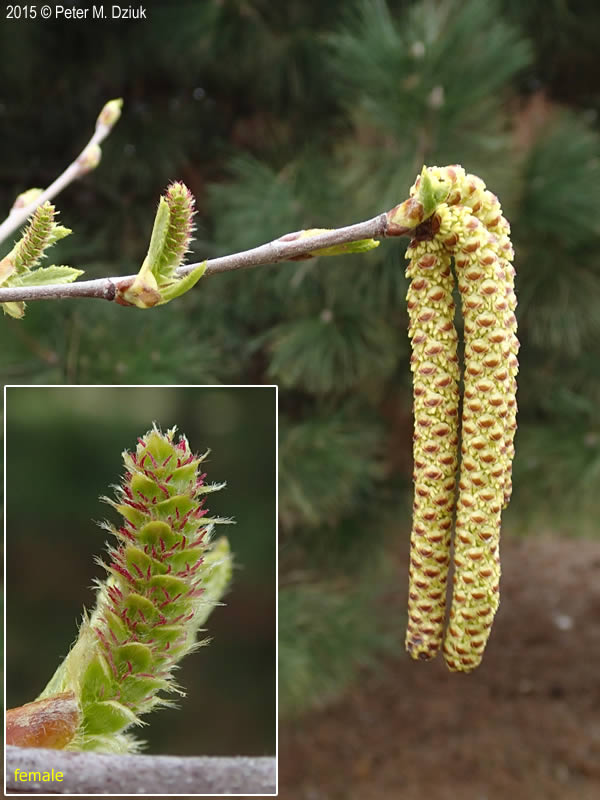River Birch
(Betula nigra L.)
Description
River birch is a very adaptable tree that can grow in a wide range of environments, but generally prefers moist and slightly acidic soils. It can grow to be 40-70 feet tall and is a deciduous tree that blooms in the spring sometime between April and May1. This tree can grow either in a single trunk or multi-stemmed pattern that will bare diamond-shaped green leaves that turn yellow in the fall2. The leaves of this birch tree are simple leaves that are generally 1-3 inches in both height and width. These leaves are arranged in an alternate pattern and have serrate margins. Male (staminate) catkins produce pollen that is wind dispersed to female (pistillate) catkins. River birch produces a cone-like fruit, and seeds are spread in late spring6. The bark of river birch peels year-round. When the bark first begins to peel it is a light-colored pink that is smooth and shiny and as the bark curls it becomes brown to blackish sheets.

River birch leaves. @Maggie, NCSU9

River birch bark and trunk aspect. @J. Robbins, NCSU 10

Male and female (inset) catkins of river birch. @Peter M. Dziuk 2015, Minnesota Wildflowers10
Distribution
The river birch occurs in river or stream floodplains, forests, and shores of rivers and lakes. It is native to the Eastern United States from New Hampshire to Minnesota and is also found in northern Florida and all the way west to Texas2. In Maryland, the river birch is found along stream banks and in moist locations such as Patapsco Valley State Park3. The broad range of the river birch is made possible by the adaptability of the tree, especially its tolerance to heat and flooding.

Natural distribution of river birch12
Wildlife Importance
River birch is a host to both Mourning Cloak and Dreamy Duskywing butterflies1. White-tailed deer are also able to browse on the tree’s twigs, buds and foliage1. The seeds of the birch tree can be consumed by small rodents, grouse, turkey, and other small birds1. Birds and squirrels are also able to feed on the male catkins (small clusters of flowers) in the late winter and early spring.
Economic Importance
The main economic use of the river birch is in landscaping because it offers both fall and winter color to parks and yards. The wood of this tree is also very durable so it can be used to make toys, artificial limbs and flatware2. River birch is a valuable source for erosion control as well and is often used to reclaim areas that have high soil acidity caused by mining5.
Threats
Some of the biggest threats to river birch are sawflies, aphids, rust, and leaf spots4. It has no serious insect pests mining11. Another threat to the tree is alkaline soils causing chlorotic foliage6. This means that the leaves will not be able to produce as much chlorophyll which is crucial for photosynthesis. Chlorotic foliage will produce pale, yellow leaves. Although river birch has a low flammability rating, it is still susceptible to fire damage.
Interesting Facts
- It is the only spring-fruiting birch tree species7.
- As a pioneer species, river birch does not tolerate shade7.
- It is one of the first species to colonize stream sides and sandbars7.
- Native Americans used river birch medicinally to treat dysentery and colds7.
- The Society of Municipal Arborists declared river birch as the tree of the year in 20028.
References
- North Carolina State Extension: Betula nigra
- The Baltimore Sun: Tose beautiful birches
- Gardenia: Betula nigra
- SFGATE: River birch tree facts
- Ohio State University: Betula nigra
- Illinois State Museum: River birch
- Society of Municipal Arborists
- North Carolina State University: Maggie and her camera
- North Carolina State University: Heritage bark
- Minnesota Wildflowers: Betula nigra
- USDA-Forest Service Silvics Vol. 2 Hardwoods: Betula nigra
- Wikimedia Commons: Distribution maps of North America
Contributed by L. Kerns and H. Morales Irizarry
